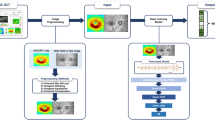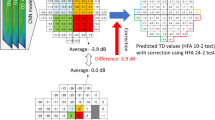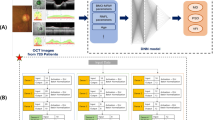Abstract
Purpose
To develop a deep learning method to predict visual field (VF) from wide-angle swept-source optical coherence tomography (SS-OCT) and compare the performance of three Google Inception architectures.
Methods
Three deep learning models (with Inception-ResNet-v2, Inception-v3, and Inception-v4) were trained to predict 24-2 VF from the macular ganglion cell-inner plexiform layer and the peripapillary retinal nerve fibre layer map obtained by SS-OCT. The prediction performance of the three models was evaluated by using the root mean square error (RMSE) between the actual and predicted VF. The performance was also compared among different glaucoma severities and Garway-Heath sectorizations.
Results
The training dataset comprised images of 2220 eyes from 1120 subjects, and the test dataset was obtained from another 305 subjects (305 eyes). In all subjects, the global prediction errors (RMSEs) were 4.44 ± 2.09 dB, 4.78 ± 2.38 dB, and 4.85 ± 2.66 dB for the Inception-ResNet-v2, Inception-v3, and Inception-v4 architectures, respectively, and the prediction error of Inception-ResNet-v2 was significantly lower than the other two (P < 0.001). As glaucoma progressed, the prediction error of all three architectures significantly worsened to 6.59 dB, 7.33 dB, and 7.79 dB, respectively. In the analysis of sectors, the nasal sector had the lowest prediction error, followed by the superotemporal sector.
Conclusions
Inception-ResNet-v2 achieved the best performance, and the global prediction error (RMSE) was 4.44 dB. As glaucoma progressed, the prediction error became larger. This method may help clinicians determine VF, particularly for patients who are unable to undergo a physical VF test.





Similar content being viewed by others
Data availability
All source codes, trained model file, and example images are available on Github website: http://github.com/climyth/VFbySS-OCT. However, original training image data cannot be made publicly available because they contain identifying patient information. Data are available upon request from the Pusan National University Yangsan Hospital.
References
Quigley HA, Katz J, Derick RJ et al (1992) An evaluation of optic disc and nerve fiber layer examinations in monitoring progression of early glaucoma damage. Ophthalmology 99:19–28
Artes PH, Chauhan BC (2005) Longitudinal changes in the visual field and optic disc in glaucoma. Prog Retin Eye Res 24:333–354
Fogagnolo P, Sangermani C, Oddone F et al (2011) Long-term perimetric fluctuation in patients with different stages of glaucoma. Br J Ophthalmol 95:189–193
Wild JM, Dengler-Harles M, Searle AET et al (1989) The influence of the learning effect on automated perimetry in patients with suspected glaucoma. Acta Ophthalmol 67:537–545. https://doi.org/10.1111/j.1755-3768.1989.tb04105.x
Langerhorst CT, Van den Berg T, Van Spronsen R, Greve EL (1985) Results of a fluctuation analysis and defect volume program for automated static threshold perimetry with the scoperimeter. In: Sixth International Visual Field Symposium. Springer, pp 1–6
Brenton RS, Argus WA (1987) Fluctuations on the Humphrey and Octopus perimeters. Invest Ophthalmol Vis Sci 28:767–771
Gürses-Özden R, Teng C, Vessani R et al (2004) Macular and retinal nerve fiber layer thickness measurement reproducibility using optical coherence tomography (OCT-3). J Glaucoma 13:238
Blumenthal EZ, Williams JM, Weinreb RN et al (2000) Reproducibility of nerve fiber layer thickness measurements by use of optical coherence tomography. Ophthalmology 107:2278–2282
Carpineto P, Nubile M, Agnifili L et al (2012) Reproducibility and repeatability of CirrusTM HD-OCT peripapillary retinal nerve fibre layer thickness measurements in young normal subjects. OPH 227:139–145. https://doi.org/10.1159/000334967
Yang Z, Tatham AJ, Zangwill LM et al (2015) Diagnostic ability of retinal nerve fiber layer imaging by swept-source optical coherence tomography in glaucoma. Am J Ophthalmol 159:193–201. https://doi.org/10.1016/j.ajo.2014.10.019
Wollstein G, Schuman JS, Price LL et al (2004) Optical coherence tomography (OCT) macular and peripapillary retinal nerve fiber layer measurements and automated visual fields. Am J Ophthalmol 138:218–225. https://doi.org/10.1016/j.ajo.2004.03.019
Sato S, Hirooka K, Baba T et al (2013) Correlation between the ganglion cell-inner plexiform layer thickness measured with cirrus HD-OCT and macular visual field sensitivity measured with microperimetry. Invest Ophthalmol Vis Sci 54:3046–3051. https://doi.org/10.1167/iovs.12-11173
Raza AS, Cho J, de Moraes CGV et al (2011) Retinal ganglion cell layer thickness and local visual field sensitivity in Glaucoma. Arch Ophthalmol 129:1529–1536. https://doi.org/10.1001/archophthalmol.2011.352
Garway-Heath DF, Poinoosawmy D, Fitzke FW, Hitchings RA (2000) Mapping the visual field to the optic disc in normal tension glaucoma eyes. Ophthalmology 107:1809–1815
Szegedy C, Vanhoucke V, Ioffe S, et al (2016) Rethinking the inception architecture for computer vision. In: Proceedings of the IEEE conference on computer vision and pattern recognition. pp 2818–2826
He K, Zhang X, Ren S, Sun J (2016) Deep residual learning for image recognition. In: Proceedings of the IEEE conference on computer vision and pattern recognition. pp 770–778
Bianco S, Cadene R, Celona L, Napoletano P (2018) Benchmark analysis of representative deep neural network architectures. IEEE Access 6:64270–64277
Foster PJ, Buhrmann R, Quigley HA, Johnson GJ (2002) The definition and classification of glaucoma in prevalence surveys. Br J Ophthalmol 86:238–242
Park SC, Kung Y, Su D et al (2013) Parafoveal scotoma progression in glaucoma: Humphrey 10-2 versus 24-2 visual field analysis. Ophthalmology 120:1546–1550. https://doi.org/10.1016/j.ophtha.2013.01.045
Chollet F (2015) Keras official web site: https://keras.io. Accessed 20 March 2020
Dubitzky W, Granzow M, Berrar DP (2007) Fundamentals of data mining in genomics and proteomics. Springer Science & Business Media, pp 177–180
Jonas JB, Budde WM, Lang P (1998) Neuroretinal rim width ratios in morphological glaucoma diagnosis. Br J Ophthalmol 82:1366–1371
Szegedy C, Ioffe S, Vanhoucke V, Alemi AA (2017) Inception-v4, Inception-ResNet and the impact of residual connections on learning. In: Thirty-First AAAI Conference on Artificial Intelligence. http://www.cs.cmu.edu/~jeanoh/16-785/papers/szegedy-aaai2017-inception-v4.pdf. Accessed 20 March 2020
Srivastava RK, Greff K, Schmidhuber J (2015) Highway networks. arXiv preprint arXiv:150500387
Li J, Fang F, Mei K, Zhang G (2018) Multi-scale residual network for image super-resolution. In: Proceedings of the European Conference on Computer Vision (ECCV). pp 517–532
Zhang Y, Tian Y, Kong Y, et al (2018) Residual dense network for image super-resolution. In: Proceedings of the IEEE conference on computer vision and pattern recognition. pp 2472–2481
Li K, Bare B, Yan B, et al (2018) HNSR: highway networks based deep convolutional neural networks model for single image super-resolution. In: 2018 IEEE International Conference on Acoustics, Speech and Signal Processing (ICASSP). pp 1478–1482
Lee WJ, Kim YK, Jeoung J, Park KH (2017) Can probability maps of swept-source optical coherence tomography predict visual field changes in preperimetric glaucoma? IOVS ARVO J 58:6257–6264. https://doi.org/10.1167/iovs.17-22697
Hood DC, De Cuir N, Blumberg DM et al (2016) A single wide-field OCT protocol can provide compelling information for the diagnosis of early glaucoma. Transl Vis Sci Technol 5:4–4
Guo Z, Kwon YH, Lee K et al (2017) Optical coherence tomography analysis based prediction of Humphrey 24-2 visual field thresholds in patients with glaucoma. Invest Ophthalmol Vis Sci 58:3975–3985. https://doi.org/10.1167/iovs.17-21832
Zhu H, Crabb DP, Schlottmann PG et al (2010) Predicting visual function from the measurements of retinal nerve fiber layer structure. Invest Ophthalmol Vis Sci 51:5657–5666. https://doi.org/10.1167/iovs.10-5239
Kawano J, Tomidokoro A, Mayama C et al (2006) Correlation between hemifield visual field damage and corresponding parapapillary atrophy in normal-tension glaucoma. Am J Ophthalmol 142:40–45.e1
Acknowledgements
The authors appreciated to the professional English proofread company, “AJE”, to ensure that the language is clear and free of errors.
Funding
This study was supported by the Research Institute for the Convergence of Biomedical Science and Technology (30-2018-017), Pusan National University Yangsan Hospital.
Author information
Authors and Affiliations
Contributions
K Park, S Kim and J Shin participated in the design of the study and in the statistical analysis. J Kim performed the statistical analysis. K Park built artificial intelligence architecture, analysed data and wrote the paper. J Shin participated in the acquisition of dataand the drafting of the manuscript, and corrected the paper. All authors read and approved the final manuscript and agree to be accountable of all aspects of the work.
Corresponding author
Ethics declarations
Conflict of interest
The authors declare that they have no conflict of interest.
Ethics approval
This study was approved by Institutional Review Board of Pusan National University Yangsan Hospital, South Korea (05-2019-134).
Informed consent
Patient consent was waived by the Institutional Review Board due to the retrospective nature of the study.
Research involving human participants and/or animals
This study was approved by Institutional Review Board of Pusan National University Yangsan Hospital, South Korea (05-2019-134).
Additional information
Publisher’s note
Springer Nature remains neutral with regard to jurisdictional claims in published maps and institutional affiliations.
Electronic supplementary material
Table S1
(XLSX 178 kb)
Rights and permissions
About this article
Cite this article
Park, K., Kim, J., Kim, S. et al. Prediction of visual field from swept-source optical coherence tomography using deep learning algorithms. Graefes Arch Clin Exp Ophthalmol 258, 2489–2499 (2020). https://doi.org/10.1007/s00417-020-04909-z
Received:
Revised:
Accepted:
Published:
Issue Date:
DOI: https://doi.org/10.1007/s00417-020-04909-z




